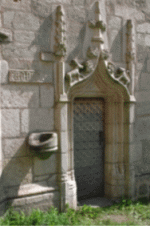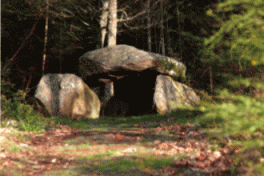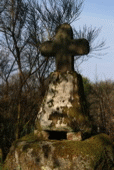Creuse’s Visible Past

- SUBSCRIBE
- ALREADY SUBSCRIBED?
BECOME A BONJOUR PARIS MEMBER
Gain full access to our collection of over 5,000 articles and bring the City of Light into your life. Just 60 USD per year.
Find out why you should become a member here.
Sign in
Fill in your credentials below.
I’ve decided to take you on a little historic tour of the Creuse. Being hidden for so long from the world has meant that a good deal of history here developed at its own pace. You must also bear in mind that the Creuse is made up of hardwearing granite and that stone is very important to the Creusois. In fact, it’s so important that you can see its influence all over France. You could also say that the Creusois have taken on the hard aspect of the stone as part of their characters. And once you know their history you’ll understand why. However, the rural beauty that surrounds them tempers this hardness.

The Blessac Dolman – Tijeras©CDT 23
Anyway, let’s get back to history. There is evidence of man’s occupation of the Creuse’s dating from pre-history; standing stones (menhirs) and dolmen can be found everywhere. I must admit to feeling awe when I run my hand over one of these monuments knowing that over
10, 000 years ago people very much like us used to treat them as everyday objects. Were they places of worship or merely decoration? Who knows? Over time, buildings became more and more sophisticated, reflecting different periods of France‘s history. Up to 1000 A.D. most structures were made of wood and very little has survived, although it’s possible to see amongst the undergrowth the remains of sanctuaries or temples. Also, between 571 and 951 the area was ravaged by a succession of plagues, Saracens, Normans and Hungarians. Building wasn’t high on the list of the Creusois’s priorities, as simply trying not to be completely wiped out probably was number one.
After that time the region was handed from feudal lord to feudal lord as France suffered during a period of loose leadership. In 1177 it passed to the English kings (even in those early days us Brits had eyes on making an Empire!). Richard III gave the territory to Hugh de Lusignan, but in 1316 his granddaughter ceded it to King Philippe le Bel. The feudal atmosphere meant that castles and fortified villages were hastily built and often just as hastily destroyed. Crozant, one of the most important fortifications of the Middle Ages in central France (now in ruins, thanks to Richelieu of the 3 Musketeers fame), is a prime example. The many fortified churches of this period are mute r eminders that not even they were protected from attack. Imagine the frightened villagers, not understanding the whys and wherefores, huddling in terror in the church praying fervently that this time they would be spared.
At the end of the 100 years War, Louis 16th encouraged the rebuilding of France, and I was during the brief period of 1480 to 1500 that many of the small châteaux were built and existing châteaux were modified. In 1545, Charles Duc d’Orléans died childless, and the Creuse passed out of national ownership. Napoleon, two World Wars, and poverty ravaged the department far more than the Revolution ever did. You can go into almost any small village and find a monument in the square or a plaque in the church listing the number of dead from the First World War. Name after name, and you wonder how these villages survived with so many of their men lying on the battlefields of the Somme. Interestingly, there’s a highly unusual monument at Gentioux-Pigerolles, showing a child raising his clenched fist in anger. above the names of the 60 war dead is the caption ‘Cursed be war’. The monument was never inaugurated, as it was not considered to be patriotic. How sad to see that nearly a century later we’ve learnt very little.) During the 20th century the population greatly decreased as the young left this impoverished area to find work. It’s only now with the arrival of many Brits wanting to live here that the trend has reversed itself.

Two very important factors greatly contributed to the department’s architectural heritage: Aubusson and Felletin and their internationally famous tapestries and the St-Jacques de Compostelle pilgrim route that has crossed the Limousin since before the Middle Ages. The tapestry towns were wealthy until wallpaper was invented and the surrounding area shows this decline. There are many manors, châteaux and estates in this hilly region, and a great number of churches, abbeys and pilgrims’ lodging houses were built along the St-Jacques route. Often they were decorated with the route’s shell symbol, which can be found on many buildings, important or otherwise, and even on furniture made in the region.
Having lived with granite for centuries, the Creusois learnt to use it for everything from coffins to palaces. For example it is possible to see these crudely carved sarcophagi in Ahun and La Souterraine. How heart-rending it is to see the size of some of them, knowing that someone spent hours carving them to house the body of some small infant. If you look closely, even humble barns will carry a carved door or window lintel, and many a small cottage will proudly display its massively carved fireplace. During most of the 19th century the Creusois exported this know-how to the rest of France. The Pantheon, the Tuileries, the Louvre and even the Papal Palace in Avignon were built by these migrant workers, often living and working in harsh conditions.
Around almost every corner there is something to see: a fortified church, a château, a menhir, or a simple stone cross rubbed smooth by centuries of wind and rain. Exploring the department is like going on an architectural treasure hunt with the pages of France‘s history to serve as a guide. Fortunately, many of the building owners are willing to open their treasures to the public.

Here are a few to whet your appetite.
Boussac, magnificent 11th to 15th century château where the famous medieval tapestries La Dame et la Licorne were discovered by George Sand.
Moutier d’Ahun, ancient Benedictine abbey with notable 17th century woodwork, and in the village a 9th century bridge.
Chambon-sur-Voueize, Norman abbey with one of the largest Norman constructions in Limousin. 13th century bell tower on two levels.
Bourganeuf, old regional capital of the Hospitaliers of St John of Jerusalem, remains of a 12th century château, 15th century Zizim Tower and church St-Jean 12th to 15th century containing the former chapel of the Commandery.
Villemonteix, 15th century château with a central donjon, containing furniture and tapestries from Aubusson and Felletin. Still lived in today.
Bénevent l’Abbaye, 12th collegial abbey particularly representative of Limousin art on the St-Jacques de Compostelle route. There, typical defensive 15th century château with a moat modified in 16th century with fountains and canals.
Masgot, small village sculpted by François Michaud a 19th stone worker.
Prébenoît Abbey, Cistercian abbey 12th and 18th century with chapel ruins.
Puy Lautard, Gallo-Roman sanctuary.
Banizette, a collection of 15th and 17th century rural buildings unique in Limousin with implements and furniture showing how the owners lived.
Le Comité Départmental du Tourisme de la Creuse
43, place Bonnyaud
BP 243
23005 Guéret Cedex
France
Telephone: 0033(0) 5 55 51 93 23
Fax: 0033(0) 5 55 51 05 20
e-mail: tourisme-creuse@cg23


